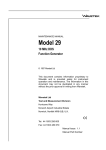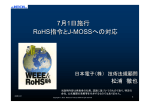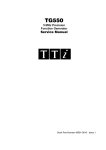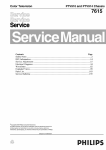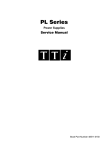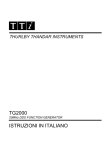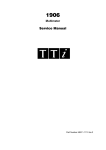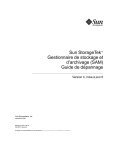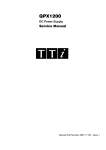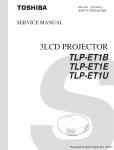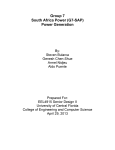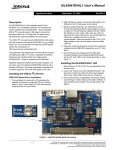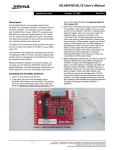Download Wavetek -
Transcript
MAINTENANCE MANUAL Model 39A 40MHz Arbitrary Waveform Generator October 2005 - Issue 1 This document contains information proprietary to Wavetek and is provided solely for instrument operation and maintenance. The information in this document may not be duplicated in any manner without the prior approval in writing from Wavetek. Wavetek-Datron Test and Measurement Division Hurricane Way Norwich Norfolk NR6 6JB, U.K. Tel: 44 1603 256600 Fax: 44 1603 256688 Table of Contents Specifications 2 Safety 10 Installation 11 General 12 Circuit Descriptions 13 Calibration 18 Parts List 21 Component Layouts 29 Circuit Diagrams 31 1 Specifications Note: This specification covers the whole series which includes 2- and 4- channel instruments; the interchannel specifications only apply to the multi-channel instruments. Specifications apply at 18−28ºC after 30 minutes warm−up, at maximum output into 50Ω WAVEFORMS Standard Waveforms Sine, square, triangle, DC, positive ramp, negative ramp, sin(x)/x, pulse, pulse train, cosine, haversine and havercosine. Sine, Cosine, Haversine, Havercosine Range: 0.1mHz to 16 MHz Resolution: 0.1mHz or 7 digits Accuracy: 10 ppm for 1 year Temperature Stability: Typically <1 ppm/ºC. Output Level: 2.5mV to 10Vp−p into 50Ω Harmonic Distortion: <0.1% THD to 100kHz; <–65dBc to 20kHz <–50dBc to 1MHz, <−35dBc to 10MHz <−30dBc to 16MHz Non−harmonic Spurii: <–65dBc to 1MHz, <–65dBc + 6dB/octave 1MHz to 16MHz Range: 1mHz to 16MHz Resolution: 1mHz (4 digits) Accuracy: ± 1 digit of setting Output Level: 2.5mV to 10Vp−p into 50Ω Rise and Fall Times: <25ns Square Triangle Range: 0.1mHz to 100kHz Resolution: 0.1mHz or 7 digits Accuracy: 10 ppm for 1 year Output Level: 2.5mV to 10Vp−p into 50Ω Linearity Error: <0.1% to 30 kHz Ramps and Sin(x)/x 2 Range: 0.1mHz to 100kHz Resolution: 0.1mHz (7 digits) Accuracy: 10 ppm for 1 year Output Level: 2.5mV to 10Vp−p into 50Ω Linearity Error: <0.1% to 30 kHz Pulse and Pulse Train Output Level: 2.5mV to 10Vp−p into 50Ω Rise and Fall Times: <25ns Period: Range: Resolution: Accuracy: 100ns to 100s 4-digit ±1 digit of setting Range: Resolution: −99.99s to +99.99s 0.002% of period or 25ns, whichever is greater Range: Resolution: 25ns to 99.99s 0.002% of period or 25ns, whichever is greater Delay: Width: Note that the pulse width and absolute value of the delay may not exceed the pulse period at any time. Pulse trains of up to 10 pulses may be specified, each pulse having independently defined width, delay and level. The baseline voltage is separately defined and the sequence repetition rate is set by the pulse train period. Arbitrary Up to 100 user defined waveforms may be stored in the 256K point non−volatile RAM. Waveforms can be defined by front panel editing controls or by downloading of waveform data via RS232 or GPIB. Waveform Memory Size: 64k points per channel. Maximum waveform size is 64k points, minimum waveform size is 4 points Vertical Resolution: 12 bits Sample Clock Range: 100mHz to 40MHz Resolution: 4 digits Accuracy: ± 1 digit of setting Sequence Up to 16 waveforms may be linked. Each waveform can have a loop count of up to 32,768. A sequence of waveforms can be looped up to 1,048,575 times or run continuously. Output Filter Selectable between 16MHz Elliptic, 10MHz Elliptic, 10MHz Bessel or none. 3 OPERATING MODES Triggered Burst Each active edge of the trigger signal will produce one burst of the waveform. Carrier Waveforms: Maximum Carrier Frequency: All standard and arbitrary The smaller of 1MHz or the maximum for the selected waveform. 40Msamples/s for ARB and Sequence. Number of Cycles: 1 to 1,048,575 Trigger Repetition Rate: 0.005Hz to 100kHz internal dc to 1MHz external. Trigger Signal Source: Internal from keyboard, previous channel, next channel or trigger generator. External from TRIG IN or remote interface. Trigger Start/Stop Phase: ± 360° settable with 0.1° resolution, subject to waveform frequency and type. Gated Waveform will run while the Gate signal is true and stop while false. Carrier Waveforms: All standard and arbitrary. Maximum Carrier Frequency: The smaller of 1MHz or the maximum for the selected waveform. 40Msamples/s for ARB and Sequence. Trigger Repetition Rate: 0.005Hz to 100kHz internal dc to 1MHz external. Gate Signal Source: Internal from keyboard, previous channel, next channel or trigger generator. External from TRIG IN or remote interface. Gate Start/Stop Phase: ± 360° settable with 0.1° resolution, subject to waveform frequency and type. Sweep Frequency sweep capability is provided for both standard and arbitrary waveforms. Arbitrary waveforms are expanded or condensed to exactly 4096 points and DDS techniques are used to perform the sweep. 4 Carrier Waveforms: All standard and arbitrary except pulse, pulse train and sequence. Sweep Mode: Linear or logarithmic, triggered or continuous. Sweep Direction: Up, down, up/down or down/up. Sweep Range: From 1mHz to 16 MHz in one range. Phase continuous. Independent setting of the start and stop frequency. Sweep Time: 30ms to 999s (3 digit resolution). Marker: Variable during sweep. Sweep Trigger Source: The sweep may be free run or triggered from the following sources: Manually from keyboard. Externally from TRIG IN input or remote interface. Sweep Hold: Sweep can be held and restarted by the HOLD key. Multi channel sweep: Any number of channels may be swept simultaneously but the sweep parameters will be the same for all channels. Amplitude, Offset and Waveform can be set independently for each channel. Tone Switching Capability provided for both standard and arbitrary waveforms. Arbitrary waveforms are expanded or condensed to exactly 4096 points and DDS techniques are used to allow instantaneous frequency switching. Carrier Waveforms: All waveforms except pulse, pulse train and sequence. Frequency List: Up to 16 frequencies from 1mHz to 10MHz. Trigger Repetition Rate: 0.005Hz to 100kHz internal dc to 1MHz external. Usable repetition rate and waveform frequency depend on the tone switching mode. Source: Internal from keyboard, previous channel, next channel or trigger generator. External from TRIG IN or remote interface. Tone Switching Modes: Gated: The tone is output while the trigger signal is true and stopped, at the end of the current waveform cycle, while the trigger signal is false. The next tone is output when the trigger signal is true again. Triggered: The tone is output when the trigger signal goes true and the next tone is output, at the end of the current waveform cycle, when the trigger signal goes true again. FSK: The tone is output when the trigger signal goes true and the next tone is output, immediately, when the trigger signal goes true again. Using 2 channels with their outputs summed together it is possible to generate DTMF test signals. Trigger Generator Internal source 0.005 Hz to 100kHz square wave adjustable in 10us steps. 3 digit resolution. Available for external use from any SYNC OUT socket. OUTPUTS Main Output - One for each channel Output Impedance: 50Ω Amplitude: 5mV to 20Vp−p open circuit (2.5mV to 10Vp−p into 50Ω). Amplitude can be specified open circuit (hi Z) or into an assumed load of 50Ω or 600Ω in Vpk−pk, Vrms or dBm. Amplitude Accuracy: 2% ±1mV at 1kHz into 50Ω. Amplitude Flatness: ±0.2dB to 200 kHz; ±1dB to 10 MHz; ±2.5dB to 16 MHz. DC Offset Range: ±10V.DC offset plus signal peak limited to ±10V from 50Ω. DC Offset Accuracy: Typically 3% ±10mV, unattenuated. Resolution: 3 digits or 1mV for both Amplitude and DC Offset. 5 Sync Out - One for each channel Multifunction output user definable or automatically selected to be any of the following: Waveform Sync: (all waveforms) A square wave with 50% duty cycle at the main waveform frequency, or a pulse coincident with the first few points of an arbitrary waveform. Position Markers: (Arbitrary only) Any point(s) on the waveform may have associated marker bit(s) set high or low. Burst Done: Produces a pulse coincident with the last cycle of a burst. Sequence Sync: Produces a pulse coincident with the end of a waveform sequence. Trigger: Selects the current trigger signal. Useful for synchronizing burst or gated signals. Sweep Sync: Outputs a pulse at the start of sweep to synchronize an oscilloscope or recorder. Phase Lock Out: Used to phase lock two generators. Produces a positive edge at the 0° phase point. Output Signal Level: TTL/CMOS logic levels from typically 50Ω. Cursor/Marker Out Adjustable output pulse for use as a marker in sweep mode or as a cursor in arbitrary waveform editing mode. Can be used to modulate the Z−axis of an oscilloscope or be displayed on a second ‘scope channel. Output Signal Level: Adjustable from nominally 2V to 14V, normal or inverted; adjustable width as a cursor. Output Impedance: 600Ω typical INPUTS Trig In Frequency Range: DC − 1MHz. Signal Range: Threshold nominally TTL level; maximum input ±10V. Minimum Pulse Width: 50ns, for Trigger and Gate modes; 50us for Sweep mode. Polarity: Selectable as high/rising edge or low/falling edge. Input Impedance: 10kΩ Modulation In Frequency Range: DC – 100kHz. Signal Range: VCA: Approximately 1V pk−pk for 100% level change at maximum output. SCM: Approximately ± 1Vpk for maximum output. Input Impedance: Typically 1 kΩ. Sum In 6 Frequency Range: DC − 8 MHz. Signal Range: Approximately 2 Vpk−pk input for 20Vpk−pk output. Input Impedance: Typically 1kΩ. Hold Holds an arbitrary waveform at its current position. A TTL low level or switch closure causes the waveform to stop at the current position and wait until a TTL high level or switch opening which allows the waveform to continue. The front panel MAN HOLD key or remote command may also be used to control the Hold function. While held the front panel MAN TRIG key or remote command may be used to return the waveform to the start. The Hold input may be enabled independently for each channel. Input Impedance: 10kΩ Ref Clock In/Out Set to Input: Input for an external 10MHz reference clock. TTL/CMOS threshold level. Set to Output: Buffered version of the internal 10MHz clock. Output levels nominally 1V and 4V from 50Ω. Set to Phase Lock: Used together with SYNC OUT on a master and TRIG IN on a slave to synchronise (phase lock) two separate generators. INTER-CHANNEL OPERATION Inter-channel Modulation: The waveform from any channel may be used to Amplitude Modulate (AM) or Suppressed Carrier Modulate (SCM) the next channel. Alternatively any number of channels may be Modulated (AM or SCM) with the signal at the MODULATION input socket. Carrier frequency: Entire range for selected waveform. Carrier waveforms: All standard and arbitrary waveforms. Modulation Types: AM: Double sideband with carrier. SCM: Double sideband suppressed carrier. Modulation source: Internal from the previous channel. External from Modulation input socket. The external modulation signal may be applied to any number of channels simultaneously. Frequency Range: DC to >100 kHz. Internal AM: Depth: 0% to 105% Resolution: 1%. Carrier Suppression (SCM): > −40dB. External Modulation Signal Range: VCA: Approximately 1V pk−pk for 100% level change at maximum output. SCM: Approximately ± 1Vpk for maximum output. 7 Inter-channel Analog Summing: Waveform Summing sums the waveform from any channel into the next channel. Alternatively any number of channels may be summed with the signal at the SUM input socket. Carrier frequency: Entire range for selected waveform. Carrier waveforms: All standard and arbitrary waveforms. Sum source: Internal from the previous channel. External from SUM IN socket. Frequency Range: DC to >8MHz. External Signal Range: Approximately 5Vpk−pk input for 20Vpk−pk output. Inter-channel Phase locking: Two or more channels may be phase locked together. Each locked channel may be assigned a phase angle relative to the other locked channels. Arbitrary waveforms and waveform sequences may be phase locked but certain constraints apply to waveform lengths and clock frequency ratios. With one channel assigned as the Master and other channels as Slaves a frequency change on the master will be repeated on each slave thus allowing multi−phase waveforms at the same frequency to be easily generated. DDS waveforms are those with 7 digits of frequency setting resolution, while Non−DDS waveforms have 4 digits Phase Resolution: DDS waveforms: 0.1 degree Non−DDS waveforms: 0.1 degree or 360 degrees/number of points whichever is the greater. Phase Error: All waveforms: <±10ns The signals from the REF IN/OUT socket and the SYNC OUT socket can be used to phase lock two instruments where more than 4 channels are required. Inter-channel Triggering: Any channel can be triggered by the previous or next channel. The previous/next connections can be used to ’daisy chain’ a trigger signal from a ‘start’ channel, through a number of channels in the ‘chain’ to an ‘end’ channel. Each channel receives the trigger out signal from the previous (or next) channel, and drives its selected trigger out to the next (or previous) channel. The ‘end’ channel trigger out can be set up to drive the ‘start’ channel, closing the loop. In this way, complex and versatile inter−channel trigger schemes may be set up. Each channel can have its trigger out and its output waveform set up independently. Trigger out may be selected from Waveform End, Position Markers, Sequence Sync or Burst Done. Using the scheme above it is possible to create a sequence of up to 64 waveform segments, each channel producing up to 16 segments and all channels being summed to produce the complete waveform at the output of channel 4. INTERFACES Full remote control facilities are available through the RS232 or GPIB interfaces. 8 RS232: Variable Baud rate, 9600 Baud maximum. 9−pin D−connector. IEEE−488: Conforms with IEEE488.1 and IEEE488.2 GENERAL Display: 20 character x 4 row alphanumeric LCD. Data Entry: Keyboard selection of mode, waveform etc.; value entry direct by numeric keys or by rotary control. Stored Settings: Up to 9 complete instrument set−ups may be stored and recalled from battery−backed memory. Up to 100 arbitrary waveforms can also be stored independent of the instrument settings. Size: 3U (130mm) height; 350mm width (2 and 4 channels), 212mm (½−rack) single channel; 335mm long. Weight: 7.2 kg. (16 lb), 2 and 4 channels; 4.1kg (9lb) 1 channel. Power: 230V, 115V or 100V nominal 50/60Hz, adjustable internally; operating range ±14% of nominal; 100VA max. for 4 channels, 75VA max. for 2 channel, 40VA max. for 1 channel. Installation Category II. Operating Range: +5°C to 40°C, 20−80% RH. Storage Range: −20°C to + 60°C. Environmental: Indoor use at altitudes up to 2000m, Pollution Degree 2. Options: 19 inch rack mounting kit. Safety: Complies with EN61010−1. EMC: Complies with EN50081−1 and EN50082−1. 9 Safety This generator is a Safety Class I instrument according to IEC classification and has been designed to meet the requirements of EN61010−1 (Safety Requirements for Electrical Equipment for Measurement, Control and Laboratory Use). It is an Installation Category II instrument intended for operation from a normal single phase supply. This instrument has been tested in accordance with EN61010−1 and has been supplied in a safe condition. This instruction manual contains some information and warnings which have to be followed by the user to ensure safe operation and to retain the instrument in a safe condition. This instrument has been designed for indoor use in a Pollution Degree 2 environment in the temperature range 5°C to 40°C, 20% − 80% RH (non−condensing). It may occasionally be subjected to temperatures between +5° and −10°C without degradation of its safety. Do not operate while condensation is present. Use of this instrument in a manner not specified by these instructions may impair the safety protection provided. Do not operate the instrument outside its rated supply voltages or environmental range. WARNING! THIS INSTRUMENT MUST BE EARTHED Any interruption of the mains earth conductor inside or outside the instrument will make the instrument dangerous. Intentional interruption is prohibited. The protective action must not be negated by the use of an extension cord without a protective conductor. When the instrument is connected to its supply, terminals may be live and opening the covers or removal of parts (except those to which access can be gained by hand) is likely to expose live parts. The apparatus shall be disconnected from all voltage sources before it is opened for any adjustment, replacement, maintenance or repair. Any adjustment, maintenance and repair of the opened instrument under voltage shall be avoided as far as possible and, if inevitable, shall be carried out only by a skilled person who is aware of the hazard involved. If the instrument is clearly defective, has been subject to mechanical damage, excessive moisture or chemical corrosion the safety protection may be impaired and the apparatus should be withdrawn from use and returned for checking and repair. Make sure that only fuses with the required rated current and of the specified type are used for replacement. The use of makeshift fuses and the short−circuiting of fuse holders is prohibited. This instrument uses a Lithium button cell for non−volatile memory battery back−up; typical life is 5 years. In the event of replacement becoming necessary, replace only with a cell of the correct type, i.e. 3V Li/Mn02 20mm button cell type 2032. Exhausted cells must be disposed of carefully in accordance with local regulations; do not cut open, incinerate, expose to temperatures above 60°C or attempt to recharge. Do not wet the instrument when cleaning it and in particular use only a soft dry cloth to clean the LCD window. The following symbols are used on the instrument and in this manual:− Caution −refer to the accompanying documentation, incorrect operation may damage the instrument. terminal connected to chassis ground. mains supply OFF. l mains supply ON. alternating current. 10 Installation Mains Operating Voltage Check that the instrument operating voltage marked on the rear panel is suitable for the local supply. Should it be necessary to change the operating voltage, proceed as follows: 1) 2) 3) 4) 5) Disconnect the instrument from all voltage sources. Remove the screws which retain the top cover and lift off the cover. Change the transformer connections following the diagram below. Refit the cover and the secure with the same screws. To comply with safety standard requirements the operating voltage marked on the rear panel must be changed to clearly show the new voltage setting. 6) Change the fuse to one of the correct rating, see below. for 230V operation connect the live (brown) wire to pin 15 for 115V operation connect the live (brown) wire to pin 14 for 100V operation connect the live (brown) wire to pin 13 Fuse Ensure that the correct mains fuse is fitted for the set operating voltage. The correct mains fuse types are: for 230V operation: 250 mA (T) 250V HRC for 100V or 115V operation: 500 mA (T) 250V HRC To replace the fuse, disconnect the mains lead from the inlet socket and withdraw the fuse drawer below the socket pins. Change the fuse and replace the drawer. The use of makeshift fuses or the short−circuiting of the fuse holder is prohibited. Mains Lead When a three core mains lead with bare ends is provided it should be connected as follows:− Brown − Mains Live Blue − Mains Neutral Green / Yellow − Mains Earth WARNING! THIS INSTRUMENT MUST BE EARTHED Any interruption of the mains earth conductor inside or outside the instrument will make the instrument dangerous. Intentional interruption is prohibited. The protective action must not be negated by the use of an extension cord without a protective conductor. Mounting This instrument is suitable both for bench use and rack mounting. It is delivered with feet for bench mounting. The front feet include a tilt mechanism for optimal panel angle. A rack kit for mounting in a 19” rack is available from the Manufacturers or their overseas agents. 11 General Service Handling Precautions Service work or calibration should only be carried out by skilled engineers. Please note the following points before commencing work. Most of the integrated circuits are CMOS devices and care should be taken when handling to avoid damage by static discharge. Also most devices are surface mounted miniature components with very fine leads on small pitches. These components must be removed and replaced with great care to avoid damage to the PCB. It is essential that only the proper tools and soldering equipment as recommended for surface mount components are used. The decoupling capacitors associated with the integrated circuits are surface mounted on the solder side of the PCB. Dismantling the Instrument WARNING! Disconnect the instrument from all voltage sources before it is opened for adjustment or repair. If any adjustment or repair of the opened instrument is inevitable it shall be carried out only by a skilled person who is aware of the hazards involved. 12 1. Remove the six screws retaining the top cover. 2. The rear panel may be removed as follows. Disconnect the grey ribbon cable from PJ6 on the GPIB PCB. Invert the instrument and remove the three screws securing the rear panel and the nuts securing the 9-way RS232 connector to the rear panel. The panel may now be tilted back to allow access. If the panel is to be completely removed the connectors must be removed from PJ3, PJ7, PJ8 and PJ11, the blue and brown wires disconnected from the mains inlet filter and the blue and brown wires unsoldered from the mains transformer. Cut the ties holding the cable assembly to the side instrument chassis. The panel is then completely free of the instrument. 3. The front panel assembly may be removed as follows. Remove the connectors from PJ2, PJ4, PJ12, PJ13 and PJ200 and desolder the screened cable from PJ202. Remove the two nuts and bolts in the sides and two screws in the bottom of the instrument securing the front panel assembly. The panel may now be drawn clear of the instrument. 4. Main pcb removal. Remove all connectors from the pcb and desolder the screened cable from PJ10. Tilt the rear panel away as in 2 above. Remove six screws and lift away the main pcb. When re-assembling the instrument ensure that all fixings use the correct fastenings. Circuit Descriptions General The following sections should be read with reference to the block diagram and the circuit diagrams. Trig Out From Previous Channel Sync Out Trig Out From Next Channel Common Hold In Common Remote Control GPIB/ RS232 Trig Out Waveform FPGA INT TRIG Common Cursor/ Marker Out 16MHz Elliptic Filter Lock Clock In/Out To Other Channels Bessel Filter 12 bit DAC Waveform RAM Common CPU PLL 10MHz CLK DC Offset Control DAC,s Common Ext Trig Common VCA In Common SUM In Amp 10MHz Elliptic Filter Zero Crossing Comparator Common CLK In/Out VCA SUM Amplitude Control Main Out Amp Output Amp Attenuators Attenuators DC Offset 0-50dB Attenuator Amp Sum Out SUM Out From Previous Channel Simplified Block Diagram Principles of Operation The instrument operates in one of two different modes depending on the waveform selected. DDS mode is used for sine, cosine, haversine, triangle, sinx/x and ramp waveforms. Clock Synthesis mode is used for square, pulse, pulse train, arbitrary and sequence. In both modes the waveform data is stored in RAM. As the RAM address is incremented the values are output sequentially to a Digital-to-Analogue Converter (DAC) which reconstructs the waveform as a series of voltages steps which are subsequently filtered before being passed to the main output connector. The main difference between DDS and Clock Synthesis modes is the way in which the addresses are generated for the RAM and the length of the waveform data. 13 Clock Synthesis Mode In Clock Synthesis mode the addresses are always sequential (an increment of one) and the clock rate is adjusted by the user in the range 40MHz to 0.1Hz. The frequency of the waveform is clock frequency ÷ waveform length, thus allowing short waveforms to be played out at higher repetition rates than long waveforms, e.g. the maximum frequency of a 4 point waveform is 40e6÷4 or 10MHz but a 1000 point waveform has a maximum frequency of40e6÷1000 or 40kHz. Arbitrary waveforms have a user defined length of 4 to 65536 points. Squarewaves use a fixed length of 2 points and pulse and pulse train have their length defined by the user selected period value. DDS Mode In DDS mode (Direct Digital Synthesis) all waveforms are stored in RAM as 4096 points. The frequency of the output waveform is determined by the rate at which the RAM addresses are changed. The address changes are generated as follows: The RAM contains the amplitude values of all the individual points of one cycle (360º) of the waveform; each sequential address change corresponds to a phase increment of the waveform of 360º/4096. Instead of using a counter to generate sequential RAM addresses, a phase accumulator is used to increment the phase. On each clock cycle the phase increment, which has been loaded into the phase increment register by the CPU, is added to the current result in the phase accumulator; the 12 most significant bits of the phase accumulator drive the lower 12 RAM address lines, the upper 4 RAM address lines are held low. The output waveform frequency is now determined by the size of the phase increment at each clock. If each increment is the same size then the output frequency is constant; if it changes, the output frequency changes as in sweep mode. The generator uses a 38 bit accumulator and a clock frequency which is 238 x 10-4(~27.4878 MHz); this yields a frequency resolution of 0.1 mHz. Only the 12 most significant bits of the phase accumulator are used to address the RAM. At a waveform frequency of FCLK/4096 (~6.7MHz), the natural frequency, the RAM address increments at every clock. At all frequencies below this (i.e. at smaller phase increments) one or more addresses are output for more than one clock period because the phase increment is not big enough to step the address at every clock. Similarly at frequencies above the natural frequency the larger phase increment causes some addresses to be skipped, giving the effect of the stored waveform being sampled; different points will be sampled on successive cycles of the waveform. 14 MPU and Memory The majority of the digital hardware in the instrument is contained in 3 LSI devices, these being a MicroProcessor Unit, IC3, and 2 Field Programmable Gate Arrays, IC10 and IC221. The Z80180 MPU contains an 8 bit Z80 core, 2x16 bit counter-timers, 2x8 bit serial interfaces and a memory management unit. The MPU is clocked at 12MHz by XTL1. The MPU provides 20 memory address lines which are used to provide access to a total of 1M bytes of memory, this comprising a 512k byte EPROM (IC4) and 5 128k byte rams IC5 – 9. The EPROM is located at address 00000h and extends to 07FFFFh. The top 128k bytes are shared by IC5 and the selection of ram or EPROM is controlled by the FPGA, IC10. The other 4 rams are located at addresses 080000h to 0FFFFFh. IC9 is the system ram which contains all the essential variables and work areas including the software stack. IC5 -8 is the non volatile store for all the arbitrary waveforms and is not used for any other purpose. The MPU selects between the memory devices via address decoders located in the FPGA at IC10. The RS232 interface is provided directly by the MPU and is buffered to the rear panel connector (PJ1) by IC1 and IC2. One of the counter-timers provides a constant 0.5ms 'tick' to the MPU which is used to time all the housekeeping functions, e.g. keyboard scan, knob control, as well as some generator functions, e.g. frequency sweep. The second counter-timer is not used. The FPGA, IC10, provides the port select signals to the GPIB board. Keyboard, LCD and LEDs The keyboard is interrogated every 10ms. This is done by reading the registers in IC12 and IC13. If a key is down then one of the transistors Q6-Q13 will be on and the corresponding bits read from IC12/IC13 will be high. The MPU decodes this to produce a key code which is passed to the software. Multiple keys down are ignored. IC10 provides the port decode signals for access to IC12 and IC13. The knob is connected directly to the FPGA, IC10. This decodes the 4 states of the switches and increments/decrements a counter. The counter is read and cleared every 10ms and the value and sign passed to the software. The 6 LEDs are driven directly from the outputs of IC18 and IC19 which are shift registers loaded under CPU control by IC10. The LCD is accessed via a bi-directional 4 bit port in IC10. FPGA Waveform Generation The FPGA, IC221, provides the complete waveform generation system including a 38-bit phase accumulator (for DDS operation), a programmable divide-by-n register (for arbitrary waveform playback), a 16-segment waveform sequencer, trigger/gate control logic, 20 bit re-loadable burst counter, multi-instrument phase synchronisation logic and an 8-bit 16 port bi-directional MPU interface. Access is provided to the waveform RAM to allow the patterns to be written and the Sync and Cursor/Marker output signals are generated. All internal operations of the FPGA are clocked by the signal ARBCLK. Note that if this signal is interrupted it is possible for the FPGA to become non-functional requiring the FPGA be completely reset. The clock could be interrupted by a fault condition or by setting the CLOCK BNC to INPUT and then providing an unacceptable clock. An unacceptable clock is any signal which overrides the internal clock but produces a replacement which is less than 9MHz or greater than 10.5MHz. This would happen if, for example, a DC voltage >2V was connected to the clock input. 15 Trigger Generator This is created by a counter-timer in IC10. The counter-timer produces a squarewave in the range 100kHz to 0.005Hz. The FPGA, IC221, may be set to use this as the internal trigger. Power Supply The transformer has two separate secondaries; one provides ± 15V by IC30 and IC31, the other provides +5V by low drop-out regulator IC32 and −5V by IC33. The display backlight is driven by a current source made up of Q22 and associated components and is approximately 150mA. IC34 provides local regulation for the +5V analogue. IC204 provides local regulation for the VCO. IC226 provides local regulation for the PLL. PJ5 is a test point for the supply rails. Four PCB mounted fuses protect the transformer secondaries under fault conditions. Required values measured at PJ5: pin 1: +5VCPU ± 0.2V pin 2: 0V pin 3: −5V ± 0.2V pin 4: −15V ± 0.6V pin 5: +5VA ± 0.2V pin 6: +15V ± 0.6V Waveform DAC and Filters IC210 is a high speed 12-bit DAC whose data is latched on the rising edge of DACCLK. The output current is 20mA fullscale giving 1Vp-p into 50Ω, from 0V to −1V. The DAC has an internal −1.23V (−1.27V to −1.17V) reference. R218 sets the full-scale output current. An internal control amplifier mirrors this with respect to the −5V rail. L201,L202,L203 and associated components form the 16MHz 7-stage elliptic filter. The inductors are factory set before board assembly and must not be adjusted. L204 provides sinx/x correction and is adjusted at initial calibration. L205,L206,L207 and associated components form the 10MHz 7-stage elliptic filter. The inductors are factory set before board assembly and must not be adjusted. L208 provides sinx/x correction and is adjusted at initial calibration. L209, C252 and C253 form a Bessel filter. L209 is also factory preset. Amplitude Control, Sum and Modulation IC215 is a 4-quadrant multiplier driven differentially via IC211. The main signal is at M and is 0V to −1V; a dc reference, M1, of half this is generated by IC200-A. Amplitude is controlled by IC218-A; with the output set to maximum the voltage at its output is approximately 1V. External AM is selected by IC214-A and is summed with the amplitude control voltage at the input of IC218-A. Sum is selected by IC214-C and the external signal is summed at the multiplier output via its Z input. IC212 and IC213 form the sum input attenuator. Amplifiers and Attenuators With the amplitude at maximum the signal at the output of the multiplier is approximately 1Vp-p. IC219 gives a gain of 5.5 to give 5.5Vp-p and IC220 gives a gain of 3.8 to give 20Vp-p. IC218-B provides DC offset for the main output; when set to maximum, i.e. +10V, IC218-B’s output will be approximately −10V and its input approximately –3.6V. Relays RL201 and RL202 select 20dB output attenuators and IC217 selects an intermediate −10dB attenuator. 16 Zero Crossing Detector IC201 is a comparator with positive feedback via R203. M is the signal selected by IC211 and M2 is the signals dc mid-point which is buffered by IC200-B. This circuit is used to detect zero crossing of high frequency DDS waveforms of sine, ramp or triangle and sent to the FPGA. Control DACs IC27 is a 12-bit voltage output DAC with internal 2V reference. IC115 provides a bi-polar output of ± 3.3V. IC28 multiplexes the DAC output voltage onto the appropriate hold capacitor. FET input amplifiers IC29 buffer the voltages on the hold capacitors. IC208 is a quad 8-bit DAC. IC209D provides a 3.3V reference to give 0 to 3.3V DAC output. IC209-A, -B and -C give gain and/or offset. VR200 gives coarse adjustment of the multiplier offset and is only adjusted at initial calibration with the default calibration values present. The voltage at each DAC output is controlled by the MPU which calculates each value from a combination of the instrument set up and the calibration constants stored in EEPROM. Reference Clock IC105 is an integrated 10MHz voltage controlled crystal oscillator. If an external clock is applied, C48 is charged up via D5 blocking the internal clock. Phase-Locked-Loop and VCO IC203 is a VCO tuned by varicap diodes D209-212. The range is 20MHz to 40MHz for square and arbitrary waveforms and fixed at 27.48779MHz in the DDS mode. Comparator IC205 gives TTL output levels. IC206 is a PLL IC and has internal dividers for both inputs which are set by the MPU. Phase comparison is done at 3kHz in PLL mode and slightly higher in DDS mode. IC15 is the loop filter which drives the VCO. LED2 is out when the loop is in lock. Inputs and Outputs IC21 is a hex Schmitt; -A, -B, -D and -E are used for the Trig In and Hold In inputs. The Sync output has four gates in parallel, IC202. IC23 is an octal 3-state buffer. When Clock In/Out is an output the top four buffers are enabled and the bottom four disabled. When Clock In/Out is an input the top four buffers are disabled and the bottom four enabled. The Zmod output high is set by the three digital signals at the input of IC16-A. IC16-A provides gain to give a maximum output high of 14V. When Q14 is on, the output is low; when turned off the output goes high until D2 conducts, clamping output high to the required level. 17 Calibration All parameters can be calibrated without opening the case, i.e. the generator offers ‘closed−box’ calibration. All adjustments are made digitally with calibration constants stored in EEPROM. The calibration routine requires only a DVM and a frequency counter and takes no more than a few minutes. The crystal in the timebase is pre−aged but a further ageing of up to ±5ppm can occur in the first year. Since the ageing rate decreases exponentially with time it is an advantage to recalibrate after the first 6 month’s use. Apart from this it is unlikely that any other parameters will need adjustment. Calibration should be carried out only after the generator has been operating for at least 30 minutes in normal ambient conditions. Equipment Required • 3½ digit DVM with 0.25% DC accuracy and 0.5% AC accuracy at 1kHz. • Frequency counter capable of measuring 10.00000MHz. The DVM is connected to the MAIN OUT of each channel in turn and the counter to any SYNC OUT. Frequency meter accuracy will determine the accuracy of the generator’s clock setting and should ideally be ±1ppm. Calibration Procedure The calibration procedure is accessed by pressing the calibration… soft−key on the UTILITY screen. CALIBRATION SELECTED Are you sure ? ◊password… tests…◊ ◊exit continue◊ The software provides for a 4−digit password in the range 0000 to 9999 to be used to access the calibration procedure. If the password is left at the factory default of 0000 no messages are shown and calibration can proceed as described in the Calibration Routine section; only if a non−zero password has been set will the user be prompted to enter the password. Setting the Password On opening the Calibration screen press the password… soft−key to show the password screen: ENTER NEW PASSWORD −−−− Enter a 4−digit password from the keyboard; the display will show the message NEW PASSWORD STORED! for two seconds and then revert to the UTILITY menu. If any keys other than 0−9 are pressed while entering the password the message ILLEGAL PASSWORD! will be shown. Using the Password to Access Calibration or Change the Password With the password set, pressing calibration… on the UTILITY ENTER PASSWORD ---- 18 screen will now show: When the correct password has been entered from the keyboard the display changes to the opening screen of the calibration routine and calibration can proceed as described in the Calibration Routine section. If an incorrect password is entered the message INCORRECT PASSWORD! is shown for two seconds before the display reverts to the UTILITY menu. With the opening screen of the calibration routine displayed after correctly entering the password, the password can be changed by pressing password... soft−key and following the procedure described in Setting the Password. If the password is set to 0000 again, password protection is removed. The password is held in EEPROM and will not be lost when the memory battery back−up is lost. In the event of the password being forgotten, contact the manufacturer for help in resetting the instrument. Calibration Routine The calibration procedure proper is entered by pressing continue on the opening Calibration screen; pressing exit returns the display to the UTILITY menu. Pressing tests… calls a menu of basic hardware checks used at production test which are self-explanatory. At each step the display changes to prompt the user to adjust the rotary control or cursor keys, until the reading on the specified instrument is at the value given. The cursor keys provide coarse adjustment, and the rotary control fine adjustment. Pressing next increments the procedure to the next step; pressing CE decrements back to the previous step. Alternatively, pressing exit returns the display to the last CAL screen at which the user can choose to either save new values, recall old values or calibrate again. The first two displays (CAL 00 and CAL 01) specify the connections and adjustment method. The next display (CAL 02) allows the starting channel to be chosen in multi-channel instruments; ignore CAL02 in this instrument and step on to CAL03. The subsequent displays, CAL 03 to CAL 55, permit all adjustable parameters to be calibrated. The full procedure is as follows: CAL 03 CH1. DC offset zero. Adjust for 0V ± 5mV. CAL 04 CH1. DC offset at + full scale. Adjust for + 10V ± 10mV. CAL 05 CH1. DC offset at − full scale. Check for –10V ± 3% CAL 06 CH1. Multiplier zero. Adjust for minimum Volts AC CAL 07 CH1. Multiplier offset. Adjust for 0V ± 5mV. CAL 08 CH1. Waveform offset. Adjust for 0V ± 5mV. CAL 09 CH1. Output level at full−scale Adjust for 10V ± 10mV. CAL 10 CH1. 20dB attenuator Adjust for 1V ± 1mV. CAL 11 CH1. 40dB attenuator Adjust for 0.1V ± .1mV. CAL 12 CH1. 10dB attenuator Adjust for 2.236V AC ± 10mV. CAL 13 CH1. Not used. CAL 14 CH1. Not used. CAL 15 CH1. Not used. CAL 55 Clock calibrate Adjust for 10.00000 MHz at SYNC OUT. Service Adjustments The following 3 sections contain information about adjustments which are normally done once only at the factory. These may need to be repeated if a component in the relevant area is changed. 19 VCO Adjustment This should not normally be necessary and L6 is sealed at the factory. However if a problem is suspected or components in this circuit have been changed carry out the following test first. Set the output to 10MHz squarewave and check that the voltage at TP200.3 is −9.5V to −10.5V. Check LED 200 is off. Only if the voltage is outside these limits should L200 be adjusted to −10V ±0.2V. L6 core must then be resealed again to reduce phase noise caused by mechanical vibration. Use only noncorrosive silicon rubber. VR200 Adjustment Not normally necessary. Must only be adjusted with the default calibration values loaded or CAL07 set to 0128. At CAL07 adjust VR200 for 0Vdc ± 5mV. Amplitude Flatness This should not normally be necessary. Set to 20Vpk-pk and use a 50Ohm terminator, frequency to 100kHz sinewave. Adjust oscilloscope to show exactly 6 divisions. Frequency to 10.00000MHz and adjust L208 for exactly 6 divisions. Frequency to 10.1MHz and adjust L204 for exactly 6 divisions. These two adjustments should only be done using a high quality oscilloscope with a bandwidth of at least 100MHz. Remote Calibration Calibration of the instrument may be performed over the RS232 or GPIB interface. To completely automate the process the multimeter and frequency meter will also need to be remote controlled and the controller will need to run a calibration program unique to this instrument. The remote calibration commands allow a simplified version of manual calibration to be performed by issuing commands from the controller. The controller must send the CALADJ command repeatedly and read the dmm or frequency meter until the required result for the selected calibration step is achieved. The CALSTEP command is then issued to accept the new value and move to the next step. While in remote calibration mode very little error checking is performed and it is the controllers responsibility to ensure that everything progresses in an orderly way. Only the following commands should be used during calibration. WARNING: Using any other commands while in calibration mode may give unpredictable results and could cause the instrument to lock up, requiring the power to be cycled to regain control. CALIBRATION <cpd> [,nrf] The calibration control command. <cpd> can be one of three sub−commands:− START Enter calibration mode; this command must be issued before any other calibration commands will be recognised. SAVE Finish calibration, save the new values and exit calibration mode. ABORT Finish calibration, do not save the new values and exit calibration mode. <nrf> represents the calibration password. The password is only required with CALIBRATION START and then only if a non−zero password has been set from the instrument’s keyboard. The password will be ignored, and will give no errors, at all other times. It is not possible to set or change the password using remote commands. CALADJ <nrf> Adjust the selected calibration value by <nrf>. The value must be in the range −100 to +100. Once an adjustment has been completed and the new value is as required the CALSTEP command must be issued for the new value to be accepted. CALSTEP Step to the next calibration point. For general information on remote operation and remote command formats, refer to the Instrument instruction manual remote operation sections. 20 Parts List PCB ASSY - KEYBOARD (44912-0710) Part Number Description Position 22224-0010 ENCODER ROT 36 POS W/O DETENT SW1 22226-0101 KEYSWITCH - ALPS SKHHBW K5-12, 20, 21, 30, 31, 48 22226-0150 KEYSWITCH LIGHT GREY K1, 2, 4, 13-19, 22-29, 32-47, 49 23202-1680 RES 680RF W25 MF 50PPM R1-3,5,11,12 23382-2470 RES PS/H 5K0 CERMET MIN VR3 25061-0200 LED - T1 ROUND (3mm) - RED LD1-5,11 35555-3010 PCB - KEYBOARD 43171-2230 CONN ASSY KB/MAIN 34W PCB ASSY – MAIN (44912-0720) Part Number Description Position 10366-9701 ADHESIVE MTG PADS 25 x 12MM FOR BATTERY 20613-0006 WASHER (SIL-PAD) TO220 FOR SK200 20613-0007 WASHER (SIL-PAD) TO220 PLAIN FOR SK2 20670-0135 CLIP GP02 FOR PCB MTG H/SINKS FOR SK2-5,200 20670-0310 HEATSINK PCB MTG 38MM PLAIN SK200 FOR IC220 20670-0320 HEATSINK PCB MTG 50MM PLAIN SK2,3,4,5 20670-0340 HEATSINK TO220 CLIP-ON 29DEG/W SK8 22010-0610 BATTERY 3V LITH 20MM BUTTON BATT 22040-0920 BEAD FERRITE – LEADED FB1,200-206 22042-0260 INDUCTOR 2.7UH L208 22042-0261 INDUCTOR 2.07UH BLK L205 22042-0262 INDUCTOR 2.0UH WHT L206 22042-0263 INDUCTOR 1.78UH GRN L207 22042-0271 INDUCTOR 1.545UH RED L209 22042-0290 INDUCTOR 1.2UH L204 22042-0291 INDUCTOR 1.322UH YEL L201 22042-0292 INDUCTOR 1.157UH RED L202 22042-0293 INDUCTOR 1.06UH BLUE L203 22042-0300 INDUCTOR 0.47UH L200 22240-0020 RELAY TYPE 53/5 (24V) RL201,202 22240-0050 RELAY TYPE 47 (24VDC) RL200,203,204,205 22315-0450 FUSE 500mAT SUBMIN PCB MNT FS3,4 22315-0453 FUSE 1.5AT SUBMIN PCB MTG FS1, 2 22573-0041 HEADER 2WAY STR SIL STD/GOLD LK1, 2, TP1, TP201/202 22573-0048 HEADER 3WAY STR SIL STD/GOLD PJ202 (CENTRE PIN REMOVED) 21 PCB ASSY – MAIN (44912-0720) continued/... Part Number Description Position 22573-0070 HEADER 4WAY STR SIL STD TP200 22573-0202 HEADER 2 WAY STRAIGHT .156P PJ3, 7, 200 22573-0204 HEADER 4 WAY STRAIGHT .156P PJ11/12, PJ13 22573-0206 HEADER 6 WAY STRAIGHT .156P PJ8 22574-0450 SKT 9W R/A D-TYPE (CLIP IN) PJ1 22575-0038 HEADER 6WAY STR SIL STD PJ5 22575-0065 HEADER 20 WAY(2X10) STR SKEL PJ6 22575-0100 HEADER 34 WAY(2X17) STR SKEL PJ2, 4 23105-0010 RES SM0805 1R00F W1 R276 23105-0022 RES SM0805 2R20F W1 R275 23105-0068 RES SM0805 6R80F W1 R274 23105-0100 RES SM0805 10R0F W1 R25 23105-0215 RES SM0805 21R5F W1 R204, 273 23105-0510 RES SM0805 51R0F W1 R200, 237, 238, 239, 244, 253, 278, 300 23105-0620 RES SM0805 62R0F W1 R219 23105-0680 RES SM0805 68R0F W1 R247, 250, 272, 277 23105-0820 RES SM0805 82R0F W1 R269 23105-1100 RES SM0805 100RF W1 R7, 225, 227, 229, 230, 249 23105-1110 RES SM0805 110RF W1 R48-51, 251, 266 23105-1130 RES SM0805 130RF W1 R58, 62 23105-1150 RES SM0805 150RF W1 R201, 213-216 23105-1180 RES SM0805 180RF W1 R220, 294, 309 23105-1215 RES SM0805 215RF W1 R248, 271 23105-1220 RES SM0805 220RF W1 R3, 59, 223, 312 23105-1470 RES SM0805 470RF W1 R36, 37, 252, 281, 293 23105-1510 RES SM0805 510RF W1 R226, 297 23105-1620 RES SM0805 620RF W1 R24, 307 23105-1680 RES SM0805 680RF W1 R311 23105-2100 RES SM0805 1K00F W1 R5,10,27,33,34,56,57,60,61,202,218,228,304-305 23105-2130 RES SM0805 1K30F W1 R268 23105-2150 RES SM0805 1K50F W1 R292 23105-2180 RES SM0805 1K80F W1 R267, 291 23105-2200 RES SM0805 2K00F W1 R222, 231, 287 23105-2220 RES SM0805 2K20F W1 R280 23105-2240 RES SM0805 2K40F W1 R19, 28, 243 23105-2270 RES SM0805 2K70F W1 R18, 22, 26, 232, 299 22 PCB ASSY – MAIN (44912-0720) continued/... Part Number Description Position 23105-2300 RES SM0805 3K00F W1 R30, 310 23105-2470 RES SM0805 4K70F W1 R23, 282, 288, 289, 290, 295, 296, 298 23105-2510 RES SM0805 5K10F W1 R233, 242, 306 23105-2560 RES SM0805 5K60F W1 R240, 270 23105-3100 RES SM0805 10K0F W1 R1, 2,4,6,11-14,32, 35 55,205,207,209-211,235 23105-3120 RES SM0805 12K0F W1 R217 23105-3150 RES SM0805 15K0F W1 R221, 236, 241, 279 23105-3200 RES SM0805 20K0F W1 R53, 54, 154 23105-3270 RES SM0805 27K0F W1 R206, 212 23105-3330 RES SM0805 33K0F W1 R155 23105-3470 RES SM0805 47K0F W1 R29, 203, 208, 234, 301, 302, 303 23105-3510 RES SM0805 51K0F W1 R17 23105-4100 RES SM0805 100KF W1 R8, 16, 20, 21, 38 23105-4200 RES SM0805 200KF W1 R15 23105-5100 RES SM0805 1M00F W1 R9 23105-6100 RES SM0805 10M0F W1 R45, 52, 224 23202-0039 RES 3R90F W25 MF 50PPM R72 23202-0100 RES 10R0F W25 MF 50PPM R70 23202-0102 RES 10R2F W25 MF 50PPM R262, 265 23202-1240 RES 240RF W25 MF 50PPM R40 23202-1750 RES 750RF W25 MF 50PPM R39 23202-2220 RES 2K20F W25 MF 50PPM R71 23206-0412 RES 41R2F W60 MF 50PPM R260, 261, 263, 264 23206-1200 RES 200RF W60 MF 50PPM R256-259 23222-0047 RES 4R70J W33 MF FUSIBLE R254, 255 23301-0443 RES NETWK SIL 22K X 8 RP1-3 23377-2220 RES PS/H 2K2 CF 10MM VR200 23424-0443 CAP10NZ 1KV CER D10 P5 C70, 71 23427-0268 CAP22PJ 100V CER NPO P2.5 C1, 4, 50, 51, 206, 207 23427-0331 CAP1N0K 63V CER HI K P5 C311 23427-0593 CAP82PG 100V CER NPO P2.5 C233 23427-9205 CAP47PJ 100V CER NPO P2.5 C245, 276, 293, 318 23427-9209 CAP33PJ 100V CER NPO P2.5 C8, 246, 248, 250, 251 23427-9218 CAP 330PK 100V CER MED K P2.5 C253 23428-0082 CAP8P2C 100V CER NPO P2.5 C232, 234, 270, 319 23428-0390 CAP39PG 100V CER N150 P2.5 C240, 242, 244, 252, 254 23 PCB ASSY – MAIN (44912-0720) continued/... Part Number Description Position 23428-0560 CAP56PG 100V CER N150 P2.5 C239, 247 23428-1100 CAP 100PG 100V CER NPO P2.5 C12, 235, 241, 249 23428-1150 CAP 150PG 100V CER N150 P2.5 C236 23428-1180 CAP 180PG 100V CER N750 P2.5 C238, 243 23461-0015 CAP SM0805 10NK 50V CER X7R C48, 210, 213, 216, 218, 219, 221, 224, 225, 271, 288, 289, 290, 292, 320, 322 23461-0020 CAP SM0805 100NZ 50V CER Y5V C3, 6, 9-11,16-41,52-57,60-63,66,67, 81, 141, 155, 200, 201,203, 204, 205,208, 209,211, 214, 215, 217, 220, 229, 230, 255, 256, 257, 261, 262, 263, 265, 267-269, 272-275, 277-279, 281, 283, 291, 294, 295,300-310, 312-317, 321 23557-0612 CAP 1U0 100V ELEC RE2 P2 C15 23557-0647 CAP 10U 35V ELEC RE2 P2 C2, 5, 13, 14, 42, 43, 76, 77, 79, 212, 264, 266, 280, 282, 285, 286 23557-0658 CAP 100U 25V ELEC RE2 P2.5 C78, 80 23557-0660 CAP 2200U 16V ELEC RE2 P5 C75 23557-0664 CAP 1000U 35V ELEC RE2 P5 C72, 73 23557-0673 CAP 22U 35V ELEC RE2 P2 C7, 202, 231 23557-9122 CAP 4700U 16V ELEC RE2 P7.5 C74 23620-0242 CAP 22NJ 100V P/E P5 C227 23620-0246 CAP 100NK 63V P/E P5 C228 23620-0249 CAP 330NK 63V P/E P5 C64, 65 23620-0252 CAP 2N2K 63V P/E P5 C226 25021-0901 DIO 1N4148 B/R D1-3, 5-9, 200-207, 213, 214 25061-0200 LED - T1 ROUND (3mm) - RED LED1, LD200 25115-0907 DIO 1N4002 B/R D10-13 25130-9201 DIO ZEN 6V2 W5 D208 25131-0224 DIO ZEN 18V 1W3 D14, 15 25131-0227 DIO ZEN 6V8 5W D16-18 25174-0224 DIO SM VARICAP BB148 D209-212 25211-9302 RECTIFIER BRIDGE W02G BR1 25334-0011 TRAN PNP TIP30 Q22 25336-5590 TRAN PNP BC559C Q1, 3, 6-13 25377-5490 TRAN NPN BC549C Q2, 4, 5, 14, 15, 20, 21, 200-205 27103-0041 IC NE527N IC201 27103-1020 IC SM AD8561AR IC205 27106-0517 IC NE5532N IC218 24 PCB ASSY – MAIN (44912-0720) continued/... Part Number Description Position 27106-0633 IC EL2099CT IC220 27106-1110 IC SM LM358M DUAL OP AMP IC16, 200 27106-1160 IC SM LM324M OP AMP IC209 27106-1170 IC SM AD8055AR OP AMP IC219 27106-1180 IC SM AD8056AR OP AMP IC25, 216 27106-1210 IC SM LMC662CM IC29, 115 27107-0071 IC SM TL071 BIFET OP AMP IC207 27151-1010 IC AD835AN IC215 27153-1050 IC SM LTC1257CS8 IC27 27153-1060 IC SM TLC5620CD DAC IC208 27153-1070 IC SM HI5735KCB DAC IC210 27158-0020 IC SM MC145170D IC206 27158-0030 IC SM MC12148D IC203 27160-0011 IC V/REG 78L05 TO92 IC108, 204, 226 27160-0013 IC V/REG 7815 TO220 IC30 27160-0020 IC V/REG 7915 T0220 IC31 27160-0210 IC V/REG LM337 TO220 IC33 27160-0460 IC V/REG L4941BV IC32, 34 27227-0510 IC SM 4051 IC28 27227-0940 IC SM 4094 IC18, 19 27236-0520 IC SM 74HC4052 IC211, 212, 217 27236-0530 IC SM 74HC4053 IC213, 214 27238-0000 IC SM 74HCT00 IC202 27238-0140 IC SM 74HCT14 IC11, 21 27239-0000 IC SM 74HC00 IC22 27239-0320 IC SM 74HC32 IC14, 15, 20 27239-2400 IC SM 74HC240 IC23 27239-3730 IC SM 74HC373 IC12, 13 27253-0020 IC SM 64180 IC3 27253-0050 IC SM 14C88 IC1 27253-0060 IC SM 14C89 IC2 27400-0140 IC 27C4001 512Kx8 EPROM IC4 27403-0010 IC SM 93C46 1K(64x16) EEPR IC17 27410-0460 IC SM 32KX8 RAM 15ns IC222-225 27412-0080 IC SM XCS10-4TQ144C IC221 27412-0090 IC SM XCS05-3VQ100C IC10 27413-0430 IC SM 128Kx8 RAM 70ns IC5-9 25 PCB ASSY – MAIN (44912-0720) continued/... Part Number Description Position 28151-0010 BUZZER BUZZ 28502-0020 RESONATOR CERAMIC 12MHZ XTL1 28515-0070 OSC MODULE 10MHz VCXO IC105 31331-9030 SCREEN PCB MOUNT S205, 206 35555-3210 PCB - MAIN FRONT PANEL ASSY Part Number Description Position 20030-0263 WASHER M3 ZPST BEZEL 20030-9201 WASHER 6BA x 1/32in. FIBRE LCD FIXING 20030-9202 WASHER 6BA x 1/16in. FIBRE LCD FIXING 20038-9501 WASHER M3 SPRING KEYBOARD PCB/FRONT PANEL 20065-0090 SCREW K22 X 5 PT LN1442 PNHDZ BEZEL FIXING 20210-0104 NUT M2.5 ZPST LCD FIXING 20234-0027 SCREW M3 X 6 PNHDPZ ZPST KEYBOARD PCB/FRONT PANEL, BEZEL 20234-0040 SCREW M2.5 X 12MML PNHDPZ ZPST LCD FIXING 20612-0011 WASHER FIBRE M3 KEYBOARD PCB/FRONT PANEL 20620-0010 CLIP - ENCODER KNOB 22219-0090 SWITCH ROCKER DPST GREY 22573-0056 HEADER 16WAY STR SIL STD FOR DISPLAY 22575-0202 SKT 2W .156 20AWG (YELLOW) IDT MAIN PCB PJ200A & PJ200B, PJ7 22575-0204 SKT 4W .156 20AWG (YELLOW) IDT INTERFACE 1 PJ6 22588-0004 BNC SKT BKHD 50R STANDARD 26100-0160 LCD 20 X 4 BACK LIT 31711-0180 BEZEL 33331-7210 FRONT PANEL 33331-7290 OVERLAY FRONT PANEL 37113-2030 KEYCAP 8X3MM LIGHT GREY 37151-0430 KNOB ENCODER LIGHT GREY 43171-1400 CONN ASSY 2 WAY 285MM PJ12, 200 (MAIN) 43171-1401 CONN ASSY 2 WAY 195MM PJ13 (MAIN) 43171-2210 CONN ASSY CRIMPED 26 REAR PANEL ASSY Part Number Description Position 20037-0401 SOLDER TAG SHAKEPROOF - 4BA EARTH 20038-9502 WASHER M4 SPRING EARTH 20063-0010 SCREW NO6 X 3/8 NIB HDPZ ST/AB 20210-0102 NUT M4 ZPST EARTH 20213-0040 CAPTIVE NUT SPIRE NO.6 20223-9001 SCREW M3 X 8 RAISED CKHDPZ MAINS INLET 20236-0010 SCREW M4 X 12 TAMPERPROOF EARTH 22115-0340 TRANSFORMER 22520-0170 FILTER - IEC INLET + FUSE - 1A 20037-0401 SOLDER TAG SHAKEPROOF - 4BA EARTH 20038-9502 WASHER M4 SPRING EARTH 20063-0010 SCREW No 6 x 3/8 NIB HDPZ ST/AB TRANSFORMER 22588-0004 BNC SKT BKHD 50R STANDARD 33331-7430 REAR PANEL PRINTED 43171-1401 CONN ASSY 2 WAY 195MM TRANSFORMER PJ1, 3, 11 MAIN CASING AND OTHER ITEMS Part Number Description Position 10144-0007 CABLE COAX 50Ω 2.6MM RG316/U BNC TO PCB MAIN (PJ202) 20030-0266 WASHER M4 ZPST RUBBER FEET 20037-0301 WASHER M3 SHK/PROOF I/T ZPST CHASSIS/F. PANEL 20038-9501 WASHER M3 SPRING CHASSIS/SPACERS, PCB/SPACERS, FRONT PANEL 20062-0700 SCREW NO 6 X 3/8 RFLNGPZ ST/AB CHASSIS/REAR PANEL 20063-0010 SCREW NO6 X 3/8 NIB HDPZ ST/AB CASE UPPER 20210-0101 NUT M3 ZPST FRONT PANEL 20213-0040 CAPTIVE NUT SPIRE NO.6 CHASSIS 20234-0012 SCREW M3 X 8 PNHDPZ ZPST CHASSIS 20234-0027 SCREW M3 X 6 PNHDPZ ZPST CHASSIS/SPACERS, PCB/SPACERS 20234-0029 SCREW M4 X 12 PNHDPZ ZPST FEET 20612-0011 WASHER FIBRE M3 PCB/SPACERS 20661-0219 SPACER HEX M3 x 15 NPBR 20662-0201 BRACKET PLAS FOOT 3786-7001 20662-0520 FOOT PVC PV2629 BLACK 22315-0232 FUSE 250MA TL HRC S/F 230V VERSIONS 22315-0233 FUSE 500MA TL HRC S/F 115V VERSIONS 27 CASING AND OTHER ITEMS continued/... Part Number Description Position 22491-0120 MAINS LD 2M ST IEC/UK PLUG 5A UK VERSIONS 22491-0270 MAINS LD 2M ST IEC/EURO PLUG EURO VERSIONS 22491-0040 MAINS LD 2M ST IEC/USA PL USA VERSIONS 22469-0203 SOLDER TERMINAL PIN (18-0223K) DISPLAY CABLE 22575-0202 SKT2W .156 20AWG (YELLOW )IDT PJ3, 7,11,12,200 ON MAIN 22575-0204 SKT4W .156 20AWG (YELLOW) IDT PJ13 ON MAIN 22575-0206 SKT6W .156 20AWG (YELLOW) IDT PJ8 ON MAIN 33171-0130 SPRING FOOT 33537-0900 CASE UPPER 33537-0910 CASE LOWER 43171-1430 CONN ASSY GPIB/MAIN 20W 43171-2250 CONN ASSY DIS/MAIN 34W 48584-0221 CONN ASSY RS232/PC SCRND 2M 28 Component Layouts Main Pcb 29 Keyboard Pcb GPIB Pcb 30 Circuit Diagrams 31 Gpib Interface Pcb Keyboard Pcb Main Pcb Sheet 1 of 4 MPU and Interfaces Main Pcb Sheet 2 of 4 Analogue Section Main Pcb Sheet 3 of 4 Waveform FPGA and Memory Main Pcb Sheet 4 of 4 Power Supplies






































